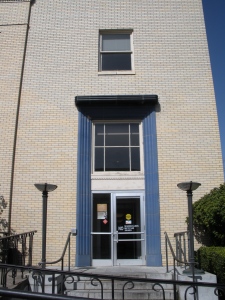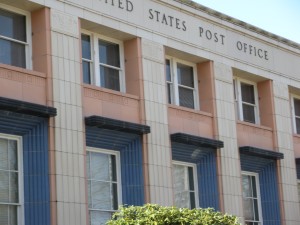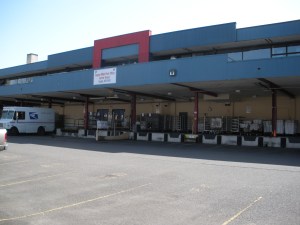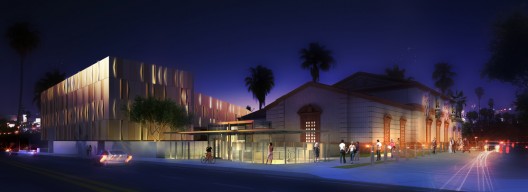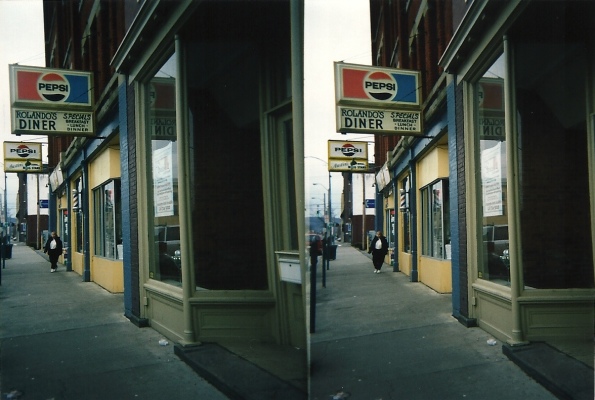Hefner Saves Hollywood
Nearly a month late to finally upload this post, I know, but just something I had wanted to do.

First of all, little known probably to most, he has for decades been a fantastic philanthropist for the preservation of old Hollywood films, giving big donations to institutions like the George Eastman House for the preservation of old reels of classic films, while maintaining a large personal collection of movies that he screens for friends and curators alike at his mansion. Now, he has stepped up again the name of cultural preservation, and bought the land near the Hollywood sign, turning at least what was a private real estate advertisement into essentially a public landmark. In fact, he prevented it from turning into a hotel, which despite the creativity, I don’t think would really preserve the spirit of the image. What a guy; funny it takes such a well-known figure to get out there and do something like this for the public good, because I’m sure he’s not the only rich person in Hollywood. Why is it he seems to be the only to care so much about the cultural legacy of Los Angeles?
Images of the Hollywood Hotel idea courtesy ArchDaily:
Greece Revolts, DOW Jones Plummets; Make Sense?
Greece Passes Austerity Measure

What I’m about to write is probably all screamingly obvious and simplistic, but nevertheless I would argue the complexity of our system is what’s leading to so much trouble recently (unless you’re someone who appreciates the volatility as something akin to a natural weather system–whereas I would prefer our system worked more predictably like man-made things ought). It’s funny how irrational our international political economy has become–a small nation like Greece has budget issues, and the DOW Industrials plummets a thousand points. I fully understand all the intervening concerns about a cooling European economy, frozen credit, and the rest, but sometimes you need to look at the larger picture. How removed has the DOW become from the performance of American industry? Europe is a huge market, but this panic underscores how American competitiveness relies on quantity of product and not quality. And how removed is financial investment from productivity? How sound is the political basis of the EU?
It all sort of reminds me of how Archduke Ferdinand is shot in Sarajevo, and suddenly the whole complicated peace in Europe between the great powers collapsed. If the stability (peace) of our economic system can depend so heavily on small events in southeastern Europe, how overly complex is this financial system? It doesn’t have enough redundancy, and the abstractions of dependencies, sort of like the ententes and alliances in pre-WWI Europe, has become over-wrought and prone to failure. If the EU really does collapse, will it ever be possible to stack the pieces of Europe together again, or is the concept fundamentally unsound?
Steel Factories into Art Factories: Limitless Potential?

Photo Courtesy Arch Daily Link to Project: http://www.artsquest.org/about/about.asp

Elbphilharmonie: three concert halls, a hotel, apartments, and a public square elevated 37 metres above the river.
It seems, at least as far back as the construction Mass MoCa in North Adams, Mass, or famously with the Tate Modern in London, there’s been a formula for turning old industrial buildings, whenever possible, into lofts or art spaces (or both or into the thing of art itself, as in the Rhur region). Economic globalization and its ballyhooed homogenizing, is rather creating strong incentives for preservation of unique places as comparatively advantageous, and the steel factories to art factories phenomenon should be seen as part of that dynamic. Pittsburgh has made this industrial to arts economic development strategy a centerpiece of its contemporary claim to fame. And I’m a fan of the project renderings shown above, and generally support the concepts behind creating the ArtsQuest campus on the former Bethlehem Steel Factory lands (although the “creativity commons” rendering gives me pause about the whole venture with its unintended parodying of a food court.) By comparison to my old stomping grounds, scores of equally impressive 19th century industrial buildings in the Naugatuck Valley, CT met their fates prematurely due to neglect and wrecking balls. They were torn down before these kinds of adaptive reuses became popularized. In fact, many continue to be torn down. Meanwhile, it seems nearly every rust belt city or defunct industrial neighborhood from NYC’s meatpacking district to Vancouver’s Yaletown or Portland’s Pearl District, have found new uses for their old warehouse areas. Cities as diverse as Minneapolis, Richmond, Cleveland, Hamburg, Manchester NH and Manchester, UK are all pursuing similar residential/arts development strategies in the adaptive reuse of their former industrial buildings. The descriptive animus of this phenomenon I would loosely describe as place-making for the creative class. It has become observably cliche(check out this beautiful example in Brooklyn). They always seem astonishingly successful, and indeed for the most part the strategy of arts-led economic development, coupled with historic preservation place-making, has proven itself in remaking beautiful, vibrant places that have challenged people’s perceptions of urban living. They are showcases of winning efforts in many American cities to staunch the tidal exodus to the suburbs. At their best, these adapted areas reminded people of the enjoyment, variety, and interest of urban spaces. Forgotten, however, are all the smaller places that either pursued the same strategies and found them inadequate, or those that never mustered the means or the political will to pursue them in the first place. An artist-led strategy for economic development has been honed with its own pat phrases and truisms for a couple decades now, with analogies to artists being the pioneer species of burnt over urban wastelands, etc, and with these, mythic, cure-all characteristics have barnacled upon the more modest proposals that underwrite the strategy.
Let me take a moment to say when I refer to the cities pursuing these strategies, or simply use “they”, I am generalizing about the nebulous confluence of real estate developers, government policy makers (who might adopt tax breaks or relax building codes for adaptive reuse), and the historic preservation organizations, art councils, and economic development departments who advocated for these arts-led revitalization of older neighborhoods.

Who or what begins the virtuous cycle of building recycling is not what I’m questioning. Unknown is how universally applicable the strategy of introducing artists to brownfields or other blighted areas is, and if there is a competitive limit to how many places can develop the same artist economic driver “niche” for their economically depressed neighborhoods, or as supplement to lost manufacturing work. Also, unknown to me is how the west coast obsession with the ‘authentic’ just makes this good real estate development.
I think the preponderance of successful art clusters are not beholden to the discretionary spending of their regions. The cities and places with formally creative arts sectors and access to worldwide markets, are places like: London, Paris, Milan, Chicago, Los Angeles, NYC, where the arts communities meet and merge with designers and big industries from furniture to advertising and media. Towns like Pittsburgh, Montreal, or Austin are, if I’m not mistaken, able to sustain their own creative, arts rooted clusters by a mixture of local market capture, linkages to larger industries (education, software, furniture design, etc.) and modest, albeit growing, appeal to tourists and regions beyond. These places and their arts led strategies must be distinguished from, let’s say, a West Hampton or Westport artist community that relies upon the patronage of wealthy residents, or a college town like Madison or Grinnell, IA that has an interested, educated class that is unusually supportive and attracts similar interest as part of a college town arts circuit. For instance, the arts community of the Berkshires is really a suburbanized section of Boston’s education/arts market. But for other towns/cities, I think the artist/creative sector (that I define more narrowly than, let’s say, Richard Florida’s creative class) has a ceiling. It’s not just any place that can adopt certain credos, put a for-sale sign on its dingiest industrial neighborhood, and sit back and wait for the famed artistic pollinator, moneybees to colonize. Expectations must be curbed, and greater recognition given to one of the main draws for artist communities: the presence of other artists in the region.
The ability of the internet to market products and services at low cost from nearly everywhere still has not changed the fundamentals of urban agglomerations–the presence of graphic, silkscreen, T-shirt companies scattered nationwide notwithstanding. Usually, in those cases where adaptive reuse of industrial areas is planned for new arts sectors, there are added catalysts like youthful demographics, an inherited legacy as a capitol of a culturally distinct region, or an educational institution (think RISD in Providence). But even with those factors, things can peter out far from the full city transformation to robust economic growth. There needs to be kindling to catch the creative sparks of an artists community–feathering a cheap, grungy, plenty caffeinated, industrial-themed nest for the creative types to roost in is not enough. Planners need to start thinking one step ahead, to creating linkages with local educational and financing institutions and to their other local industries, to see how artists and designers might work together with local industries to improve and enhance their global competitiveness. I believe this is done more effectively in other nations, whether its the way in which Italian regional governments market traditional, artisanal products into international brands and products, or how South Korean corporations/government are adamant in sponsoring excellence in broad categories beyond the technological, understanding how creativity in different fields form positive feedback loops. For instance, in much the same way Silicon Valley computing power and human capital can help the affect the animation businesses of Hollywood, or the publishing and television industries in NYC benefit from the presence of so many local actors and models, so can the smallest American communities be able to build places that make obvious its talented, creative people’s usefulness to other businesses, even if done on more modest scales of arts fairs and local restaurants. Adaptive reuse of lost industrial buildings and places is important, not because artists and designers are going to create the quantity of middle-income jobs manufacturing has lost, but because they often involve the concerted planning efforts of many different stakeholders in order to find complementarity between disparate industries and demographics of a city or region. In essence, they can make a splash.

"The Shirt Factory is a community of over 35 artists who thrive and collaborate in an environment devoted to the arts."
Indeed, I do not think the successful adaptive reuses in economically depressed regions, combined with this arts-led strategy, has ever been about the arts or historic preservation, but something deeper and more to do with high school civics class (those of us who had it). I think its productivity is sourced in bringing together people from diffuse disciplines and backgrounds to concentrate on the creation of new spaces. In this creative enterprise, they imagine their city as a productive locus to enact partnership possibilities. Opportunities are invented.
The use of the historic industrial buildings is key on two levels. Immediately, the efforts are symbolically part and parcel of the city and as keeping in continuity with local heritage, and start to change what might have been a longstanding negative narrative. Even so, there is still a real risk of backlash against the effort as either a gentrifying front, or as a foreign intruding presence meant to irritate or annoy, but ultimately impossible for their particular place (low self-esteem is common to cities plagued with brownfields.) Secondly, the results are tangible and generate positive momentum, buzz, and begin a trend that can cause further investments from previously hesitant or doubtful residents.
Using previously long disused buildings is difficult to object to (although sometimes done) and celebrating their appearance also works to soften gentrifying criticism, and often puts the new business or new residents deep in the heart of older neighborhoods where they cannot fail to be seen and where they will immediately start depending upon, and supporting, local services. They will believe themselves closely identified to the city, and in turn the city will eventually embrace them. This is to be contrasted with the way many light industry business parks were erected on the edges of cities, close to suburbs, as tax and subsidy havens that were devoid of any other compelling reasons to exist other than to retain the business nominally within city limits.
Once located near the edge of town for the sake of tax breaks, those subsidies had to be constantly maintained or enriched. Once located on the edge, the impulse to just cross the line out of town or state to even cheaper conditions proved too strong, the reasons for physically clustering in the center exposed as no longer relevant, and the gravitational force of the city center irreversibly compromised and weakened. Therefore, money not spent on keeping the local workforce more educated and superior in order to retain manufacturing advantages, was, in the final analysis, wasted.
In contrast and superficial as it might seem, creative or so-called ‘human capital’ intensive operations, like those of artists or designers, are seen as irresistibly drawn to the unique attractions of an urban agglomeration and not reliant upon the erection of special tax haven business parks or the ‘right amount’ of government financing. Instead, cultural ‘things’ like music venues, coffee bars, museums, parks, other similarly aged or like-minded people, and even squishier terms like tolerance and heterogeneity, could be given as reasons for competitive advantage. This is a list that starts to sound suspiciously equivalent to a good tourist guidebook (of course artists also need art dealers, clients, and fellow artists in order to support themselves, although the links between popular tourist destinations and the arts is obvious), but the attractiveness of such a theoretical approach to many desperate communities is apparent. It is also a list with a lower threshold to meet than the hard work of institution building once large company sponsors and patrons had left. That’s the danger in the current economic development storyline of attracting creative class people and its strategies–it can build hope on flimsy premises and scattershot precious resources, while ignoring doing the heavy lifting of connecting employers to educators, enabling networking, and expanding the public realm and its concordant services so to make the place itself indispensable to many operations. Quality of life issues are important, connections between people is more important.

Map Courtesy http://www.CreativeClass.Com
Anyways, is this just the nature of comparing manufacturing versus creative sectors, or is the location and building types the key difference? In the past, manufacturing sectors in America were also considered ‘human intensive’, especially as was the case with the famed Yankee ingenuity of the Northeast in celebrated economic powerhouses like Bridgeport, CT. And we can observe in East Asia that manufacturing, especially advanced manufacturing, is not resource based but still very ‘human capital‘ intensive and still cluster at points where skills and know-how can layer and build. So, indeed, I think there is a portion to this that is straightforward bricks and mortars geography, where centrally-located historic buildings are being adaptively reused demonstrate city vitality and can create a self-fullfilling perception that the city is inventive and renewing itself, and when done so in localities near to their legacy infrastructure investments it can reassert the city’s regional centrality and optimize the whole system. One look at the historical tenacity with which the financial sector has clung to Lower Manhattan’s outmoded skyscrapers in-close to the Stock Exchange (after 9/11 being converted when feasible to residential buildings), and then to Midtown and NYC metropolitan area more generally, will support the view that labor markets exhibit a certain stickiness to one another and, importantly, to a geographic place. Corporations might list HQ in the Caribbean, but the executives and work is still done on the Gold Coasts of Long Island Sound and Lake Michigan. On any scale, location counts.
The idea of artists as ‘pioneer species’ or ‘pump-primers’ who spearhead new imaginative undertakings and initiatives in the most blighted and oldest city areas, thus pouring revitalizing wine into old depreciating vessels, then whose efforts will in time attract wealthier suburban consumers to return like cultural vultures to downtown areas to shop and dine once more, which in order leads to more lucrative operations like developing real estate, and then through an increasingly vague and muddy process results in economic rebound for the whole of the city. Oddly enough, even when I put it in this mangled mishmash of metaphors and give misleading emphasis, I do not believe the approach is without merit; when we understand it as a method for communities to work together imaginatively on a new city-building project. Non-profit arts institutions working with government leaders and private developers to fund the rehabilitation of old structures involves organizing a very diverse and broad group of actors. Yet, the bringing of arts and artists to a town must be remembered not as an end unto itself in most cases, but as purely a cheap means for places that are resource poor to do something productive together. This confusion, however, of artists as economic development ends rather than means, can lead to the foolish funding of large performing arts spaces and the like often in small cash strapped places without any aforementioned criteria for successful arts clusters, which in the end is likely to have as much effect on the local economy as a new sports or ballpark. Equally damned but perhaps far more heroic, is the quixotic pursuit of brave souls in a place like Butte, MT to make themselves the bohemian capital of the Old West, one funky bistro at a time. Artists, or their nerdy computer programmer cousins, who in the past almost legendarily have been recruited to live and work in ratty warehouse locations on the promise of open floor plates, lots of sunlight, and perhaps some dive bar, might have been a cicada-like boon once seen in a blue moon. Their future decision-making should not be over-thought or over-sought in economic development plans–their caprices are subject to sudden, unpredictable change from industrial buildings (as pointed out in the end of this interview).
There is also certainly an element of the trendy involved in the rediscovery of the city as a desirable place to live and that has had at least as much to do with dropping crime statistics as a new appreciation of factory aesthetics. Fostering complementarity and cooperation between creative professionals and the economy writ-large, rooted in well-designed places with strong continuity and respect for places’ formative heritage, should remain uppermost in the clear minds of policy makers. Building the same cooperation around urban agriculture, or a new credit union, or building apprenticeships between schools and artisan workshops might in many instances be more valuable than a big orange box.
That said, for many mid to small cities without bustling, commodified culture scenes, their factories are closed, their mines are closed, their timber mills are closed, but their imaginations should not be.
(this video, to me, is a reminder of the fleeting nature of things. and i’m not just talking about the decaying industry buildings.) Also, a plug. Please save Remington Arms Factory: http://www.archdaily.com/57093/help-save-remington-arms-factory/
Now, belatedly after all this opining and pontificating, I will read Alex Cuthbert’s “The Form of Cities: Political Economy and Urban Design” Anyone else already read it? Always a good thing to read about how planning history is a “moribund subject” and how planning is a ‘mongrel discipline, ritually bred from elementary particles derived from social science, economics, architecture, urban geography, law, engineering, etc.’ whose only ‘claim to be a profession is only by virtue of its legitimation by the state’.
China Goes Back to Bikes? Not really.
http://news.bbc.co.uk/2/hi/asia-pacific/8538221.stm
Apparently, according to this BBC news story, the fastest growing form of transportation in China isn’t high speed rail or cars, it’s electric bikes. It’s more likely that the electric bikes are a stop gap measure for people as they upgrade from regular bikes to cars on the old ladder o’ material prosperity, so I won’t dare believe our environmental problems are going to be mitigated by this development.
I think electric bikes are probably a nice intermediate step for those hundreds of thousands of Americans looking to downgrade from a car (hopefully for lifestyle choices and not just because they’re going back down the old ladder o’material prosperity). Supposedly, there is a contest right now in China over their safety between ‘cycling activists’ and the urban planners of China. Having never ridden one myself, how do they function with some of the newfangled bike infrastructure being built out there? Do they increase the area people feel comfortable traversing on bike, in terms of distance and not just for hills?
Ruins Ruined.
http://news.bbc.co.uk/2/hi/europe/8595660.stm
I was just a little saddened by the collapse of the Golden Palace because they were renovating it when I visited, and I couldn’t go inside. Now, it seems ruined. Nothing endures forever. C’est le vie.
SOS USPS Oregon Art Deco Post Office for Sale
Eugene Post Office Up For Sale–Murals and All
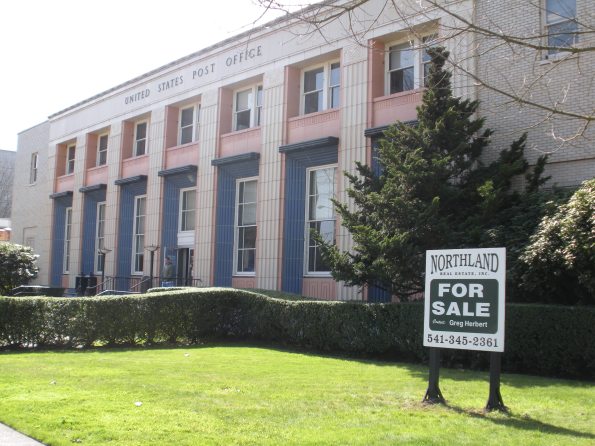
I took some pictures of the Eugene Post Office and the context of its neighborhood, and would like to just give a few thoughts about why buildings should be preserved and reused, this structure’s situation to its environs, and some ideas for potential future use. I liked what Gary Jarvis, a local employee, gave as a reason why he did not want the building sold “That’s the face of the post office the community has come to know,”. Indeed, many post offices like this one in Eugene is a face of government once known, but now fading. Unfortunately, the United States Post Office is going to sell hundreds of buildings like these because the USPS just isn’t going to need as much capacity going forward. Yet, these structures are strikingly unique and immediately recognizable symbols of our civic culture. The facades and foyers, made up of expensive materials expertly executed, have value beyond the inner sorting rooms and empty offices (33,000 sq. ft. worth in the case of this building). It’s listed on the National Historic Register of Places, not just because of the larger architecture design of Gilbert Underwood, but due to the interior art murals by Carl Morris. It’s a quintessential example of FDR’s public works projects and an expression of optimism in government.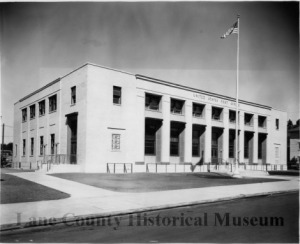
Walking around the building, as with many buildings from this time period, the individually designed fixtures stand out. Objects such as the iron fences, window grills, and lamp posts–all of the kinds of details that once they disappear, the effect on an observer of the artifacts is simply impossible to replicate. People unconsciously pass by these sort of details everyday, but even if they aren’t consciously thinking about the history and culture these objects link to, I believe their existence alone can foster awareness within individuals of the cultural norms they participate in day-to-day. They remind people that societal conventions are invented and they have a role to play in their reinvention. From 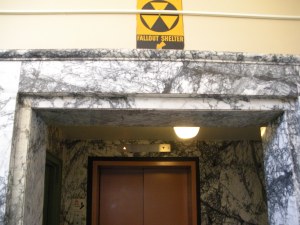 the solidity of iron materials with slight imperfections indicating the work of human hands, to a hanging lighting fixture patriotically marked with star, or a sign to the Nuclear Fallout Shelter that recalls for the psychologically of the long cold war period, and to the polished marble walls that are actually expression of common cause with Greek and Roman republican virtues–together they manifest continuity with the past and mnemonically mark the plans and labor of previous generations in our present consciousness. And by preserving, reusing, and ultimately enhancing the shared inheritance of these structures that link to the past, we are also creating a connection in our present time to the future. Only by renewing the old can our society hope to orient its present day efforts to long-term planning and goals.
the solidity of iron materials with slight imperfections indicating the work of human hands, to a hanging lighting fixture patriotically marked with star, or a sign to the Nuclear Fallout Shelter that recalls for the psychologically of the long cold war period, and to the polished marble walls that are actually expression of common cause with Greek and Roman republican virtues–together they manifest continuity with the past and mnemonically mark the plans and labor of previous generations in our present consciousness. And by preserving, reusing, and ultimately enhancing the shared inheritance of these structures that link to the past, we are also creating a connection in our present time to the future. Only by renewing the old can our society hope to orient its present day efforts to long-term planning and goals.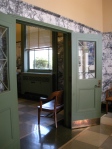

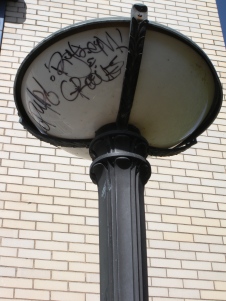
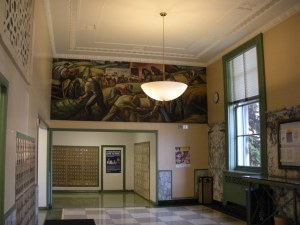 As for the building itself, I believe much can be done with it once it finally loses all postal functions. There is a large addition of a mail sorting room, replete with docking bays for mail trucks. This large open floor plate area is strategically located in a neighborhood of several successful historic buildings being commercially reused, and near the train station, so altogether is very well positioned to survive.
As for the building itself, I believe much can be done with it once it finally loses all postal functions. There is a large addition of a mail sorting room, replete with docking bays for mail trucks. This large open floor plate area is strategically located in a neighborhood of several successful historic buildings being commercially reused, and near the train station, so altogether is very well positioned to survive.
The foyer of the building is beautiful in some of its finishes. However, I have noticed that the immediate surroundings are perhaps already high on public uses. There is a prison, and a probation office, and several other social services leasing office space near adjacent to the post office already. Eugene already has a very crowded indoor farmer’s and crafts market in their convention space on the other side of town, but its only accessible by car. The location of the post office is eminently walkable to many businesses on Fifth and Sixth Avenue, including the performing arts theater and the Hilton Hotel. The area is prime for more dense residential structures in the future, and even if rail doesn’t becomes more a popular commuting choice, the location is near the highway, a new bikepath to the river and its parks, and some of the best restaurants and shops in town (I’ve found it peculiar that these things coexist at ease so closely to the prison, but they do. I suspect this is an East-West culture shock moment). Indeed, this region between Fifth Street and the Train Tracks and 6th Ave, is taking on a more lively downtown center feeling than, well, the current CBD which is quiet, dead, and slightly menacing in character, but only a short if unpleasant walk across Rt. 126. The city has labored hard over decades to revive the downtown, but really I think there should be a shift in priority to this area, where although there are some vacancies indicative of the current economic situation, there is positive activity year-round and at night. Nighttime bars, restaurants, a movie house, an overabundance of parking (ripe for development), bookstores, gift stores, apparel shopping like Buffalo exchange, lunch hour traffic from the Federal court houses, and several home goods stores.
If the area were to be developed more densely with more residential uses, I think the Post Office is an excellent candidate for relocating the Thursday and off-weather Farmer’s Market. Currently, the indoor markets at Lane County Fairgrounds, are entirely self-contained affairs with little to no spillover effects. Personally, I think once the Post Office is at last completely finished with the building, it should be turned over to the city for a rehab. Punch out the ceiling of the mail room to bring in some light and expand the feeling inside, and move some of these successful markets into the post office, where their traffic can spill over and effect the large amount of local businesses in the area and improve the viability of more, dense residential structures (the ability to walk to a farmer’s market for food is highly desirable for people who want to walk, bicycle, or perhaps in the future, take the train to work). This is an attractive, interesting area, and is more likely to vitalize downtown from the outside-in, rather than trying to shoehorn things into the unappealing, lifeless buildings and streets of downtown.
The other local venue that could serve as a model is the W.O.W. Hall—
SOS USPS: Post Office Buildings Going for Sale
When the Federal government determines buildings are no longer useful, they put them up for auction through the GSA. Other Federal agencies, nonprofits and educational uses are supposed to get first dibs, but if nobody wants it, the GSA does have a whole department to support its “good neighbor” policy by facilitating local planning efforts to reuse federal buildings. Whether or not they’re first consulted in disposing of Federal buildings, or if they wait to act only when the local community or citizens approach them, is something I will have to investigate further. As I wrote in a previous post, I would love to see the thousands of soon-to-be-vacant post offices turned into new public facilities rather than just all be turned into restaurants, sit empty, or fall to wrecking balls. In the case of the Eugene Post Office (seen here,) a property in seemingly exquisite condition and on the National Register of Historic Places, as well as in a neighborhood of older buildings put to new commercial uses, I think the worst case scenario is off the table. However, I doubt this will be the fortune of all the closing post facilities.
Now, the GSA website has up a list of success stories, by state, of successful property donations. Oregon’s case example was the provision of an emergency school when the one in the town of Sheridan burnt down. I found this a bit short and pretty lame–maybe the GSA needs a publicist, or maybe despite their desire to find local partners to take these buildings, most federal buildings/infrastructure just end up in the marketplace. It leaves me to wonder if there is going to be a thoughtful process of divesting the U.S. Post Office of its infrastructure, or if in the end it will be completely ad hoc. In this case, I think opportunities are going to be missed because of the lack of any federal leadership. Localities–not all but many–will most likely scrap to keep their particular offices open for as long as possible, and then will be completely apathetic as to the final outcome for the post offices.
Some of our wealthier places, as here in Beverly Hills, might be able to not only secure funding but recreate the historic building into something noteworthy for the community. However, these will most likely be the exception to the rule. Also, if the thought is that these structures should be put to purposes of economic revitalization in depressed regions, I believe the default option of making new community theaters, performing arts places, and the like is sort of played out, or at least overhyped. Building new cultural and arts institutions makes sense for many medium to large metro-areas that are most likely starved for these sorts of local opportunities, but I think the strategy of just building these edifices in the hopes of creating bohemian clusters is oversold to many places that it isn’t likely to take. Also, much like the arguments made in behalf of public funding for sports stadiums and arenas in the name of economic development, the idea that these spaces will automatically create spillovers for downtowns does not comport with reality. But this is clearly a topic for another post.
Back to the subject of how the GSA is most likely to dispose of hundreds, and thousands, often uniquely designed, federal post office buildings in the near to medium term. There is, of course (as usual), an argument to be made that leaving things up to local markets to decide the fate of these buildings is the finest, truest method for determining the maximum utility these structures will have for society. I’m divided in my opinion because while I would prefer localities to take the lead (they will best know optimum use and needs) many places lack the sort of informed citizen engagement necessary. In addition, I believe these post offices are going to come up onto the market without much far warning, and as a surprise to local historic preservation or booster groups. Furthermore, thinking from a good government perspective, I would question whether other agencies have thought creatively about how they could take advantage of these thousands of retailing centers strategically located nationwide. It’s understandably not a priority at this time, and expansion has costs. I think it would be desirable for the GSA to analyze each property its disposing, and then shop the building, recommending uses, to targeted agencies and local actors.
For instance, given the GSA’s other mission to provide child care centers, and given the open floor plans post office mail sorting rooms offer, a systematic approach to convert mail rooms to Head Start centers , might be an option. Another might be to help close the digital divide that still persists by the creation of library branches dedicated solely to access to computers, the internet, and multimedia. Other community “3rd place” options would vary greatly by building and location, but include dedicated voting centers (no more closing school early to turn the gym into voting location), fitness centers, clinics, etc. As is the case with the Eugene, Oregon Art Deco structure, Post Offices were designed to grandly express the civic virtues of our republic with Greek temple like entrances. Even with their musty post office odors, I believe the foyers and entrances of these buildings is inspirational and instructional, and we must aspire to fill them with programs and frequent uses that befit their design and influence future generations. These future functions might be private and commercial, but besides the niche bistro I doubt it. I prefer a hold on the sale of former USPS buildings, a thorough and systematic examination of these buildings for continued public use, and if it could be managed, funding for their retrofits and conversion. I photographed the Eugene Post Office and the context of its neighborhood and will soon be posting some thoughts about the structures situation to its environs, and potential future use.
What makes the mundane marvelous?
I really think this kiosk rendering has hit on something. I think this design is simple, beautiful,
functional and uncluttered (but not boring or unadorned). It’s the kind of design for the built environment that I don’t think can be ‘planned’ or forced by any sort of government action, but can only be achieved through the values of average denizens to demand that everyday things in their lives reflect cultural values. I find it pretty rare for the day-to-day commercial structures or infrastructure in America to be built with such an obvious concern for surroundings. In NYC or a national park you might find some concession stands making forced attempts to be inconspicuous, but that isn’t exactly what I like. The post offices of yesteryear I think more closely hit the mark–but their commercial nature is debatable.
When we look at streetscapes in many contemporary East Asian cities we often see pictures of a forest of neon calligraphy, advertising this or that product or shop. In America, we see a similarly motorized version of this, as Robert Venturi so famously has described. These kinds of commercial streetscapes can be functional and still beautiful, since much depends on your subjective understanding of what constitutes a beautiful landscape. However, they contrast strikingly with Victorian commercial buildings, American Main Streets, or Italian gallerias of earlier eras for reasons that go beyond new materials, new construction methods, and new technological demands. There was more going on in these approach of building small shops. There was pride of ownership and individuality evident that is different than the pride of ownership we see in small businesses today, especially and obviously when they’re franchises. There were normative ideas about how to relate your building to others without government direction. Yet, today, too many planners and designers are finding it necessary to rigidly demand less inspired designs to achieve this lost sense of place that attaches to an area or neighborhood that is working individually but in concert with one another to beautify their street. Usually this is in response to blight, sometimes in response to long, windowless walls from modernists.

Personally, I prefer when there is a demanding public who, perhaps almost unconsciously pursues an infusion of a particular aesthetic or humanist appeal into mundane structures of everyday life. Many places still seem to engage in this effort to beautify effortlessly, without prodding from local boosters or government, but as a matter of course of doing business. Not surprisingly, I’ve encountered this taking place in self-styled fashion cities like Montreal. In the early 20th century, American cities were full of businessmen who were criticized for their vulgar displays of wealth by building ornate facades of eclectic styles on even the most ordinary buildings. Bakeries and banks alike felt compelled to make architectural statements. Today, some painted numbers inside a window suffices. There are many imaginative people amongst us who can find a charm to these sorts of scenes. However, the beauty in the public realm is really being left to individuals to perceive, and is not consciously made. This salumeria might have once unconsciously arranged meats in the window this way, but that was perhaps centuries ago, and there is definitely an artifice to these arrangements today ( no less lovely for being so ). The comparison to an average American meat market (those that survive I suppose) or the local bodega is obvious. Is it a matter of money, or a cultural difference in taste or panache? There are two trends in our supermarkets today, either to update the interiors to resemble cafes and high end food markets (like Wegmans, some Whole Foods, etc) or downgrade to Super Wal-mart, Costco warehousing. Some would argue the Wal-Mart model is on its way out after peaking, but their profits haven’t shown this–yet.
The more extreme among us (Americans, not British or Dutch) would try to rectify this lacking attention to visual appeal through city adopted design codes. I think there is some validity to discouraging or even outlawing things we know are deadening to the public realm (long, uninterrupted spells of wall facing a sidewalk or public street, , max. setbacks instead of minimum ones, for instance). But when it reaches the point of dictating what kind of eaves a building should have, we have perhaps gone too far. Admittedly, this is a fuzzy standard, and too much relies on what is ultimately just the considered opinion of experts (subject to constant change) and nothing further. What is it going to take to make everyday, vernacular architecture of things like gas stations, retail outlets, concession stands, etc to become more design conscious? Is it recognizing some hidden economic cost of ugliness, or is it just an awakening of values? Or am I missing something already around me?
oy
Topeka kansas renames itself google. (http://www.cnn.com/2010/TECH/03/02/google.kansas.topeka/) i’m undecided, could there be anything more exemplar or antithetical to the civic booster spirit I referenced in my first post?






